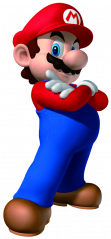Mario
From Sonic Retro

|
This article needs cleanup. This article needs to be edited to conform to a higher standard of article quality. Specifically, issues with this article are:
There are not enough references to back up claims.
After the article has been cleaned up, you may remove this message. See How to Edit a Page for help. |

|
| Mario |
|---|
| First seen: Donkey Kong (1981) |
| Species: Human |
| Gender: Male |
| Created by: Shigeru Miyamoto |
Mario is a character created by Shigeru Miyamoto to be the protagonist in Nintendo's 1981 arcade game Donkey Kong. Following the success of Donkey Kong, the character would appear in more arcade titles, and would eventually rise to iconic prominence following the release of the overwhelmingly successful 1985 home console game Super Mario Bros. for the Nintendo Entertainment System. Consequently, he became Nintendo's official mascot character.
In the initial Japanese release of Donkey Kong, the character was originally called "Jumpman" and was a carpenter. When the game then launched in the United States, the character was renamed as Mario, and depicted as a stout, mustachioed Italian man from Brooklyn. In the 1983 arcade title Mario Bros., Mario changed his occupation to being a plumber, which became his vocation ever since.
He is one of the most recognised video game characters of all time, even among mainstream audiences worldwide. At one point, it was reported that more children in the United States recognised him than Disney's Mickey Mouse. His iconic status was also one of the motivations behind the creation of Sonic the Hedgehog as Sega's own mascot character, and during the console wars of the 1990s, both characters were often pitted against each other as rivals by both the fandom and the press. This was largely the case when Sega was Nintendo's biggest competitor at the time, before Sega stopped making their own consoles, and became a third-party publisher by 2001.
Mario's popularity waned slightly in the 2000s, as Nintendo lost much of its market share to Sony's PlayStation and Microsoft's Xbox series of consoles, in addition Nintendo largely paused licensing Mario into other media for a period of time, focusing on his video game appearances with many spin-off titles, ultimately including official crossover titles with Sonic the Hedgehog.
Mario was voiced or portrayed by multiple actors in the early years of various non-gaming media, including Bob Hoskins in the 1993 live-action film Super Mario Bros.. Charles Martinet has been Mario's official voice actor in video games since 1994, before being succeeded by Kevin Afghani in Super Mario Bros. Wonder onwards.
Contents
Overview
Mario is an All-Around Type character in Mario & Sonic at the Olympic Games.[1] In Super Mario Maker, Mario can put on a costume to look like Sonic by using a Sonic Amiibo.
| |
This short section needs expansion. You can help Sonic Retro by adding to it. |
History
Mario debuted in the game Donkey Kong with the name "Jumpman". He had to rescue his girlfriend Pauline from the clutches of an evil, gigantic ape Donkey Kong. He was supposedly named after Mario Segale, the landlord of Nintendo of America's Seattle warehouse, to whom he bore a striking resemblance at the time. The preceding games usually involved him saving Princess Peach, and the 1993 Hollywood film based on the game series followed this theme, but used Princess Daisy instead (or her name, at least).
Mario and Sonic both experienced the peaks of their careers at the same time, and as a result they were seen as fierce rivals and are often used to represent each company in the battle between the Sega Mega Drive and the Super Nintendo Entertainment System. Mario is often seen as the opposite of Sonic, despite both sharing similarities in their playing styles.
After Sega gave up on creating consoles, Yuji Naka and Shigeru Miyamoto have both expressed an interest in creating games together, including the possibility of a game with both Sonic and Mario in it. The two earliest games featuring both characters were Mario & Sonic at the Olympic Games, which was published by Nintendo in Japan and Sega elsewhere to tie in with the 2008 Beijing Olympics of that summer, and Super Smash Bros. Brawl. The success of the former spawned the Mario & Sonic spin-off series, as the first game was followed by Mario & Sonic at the Olympic Winter Games in 2009, Mario & Sonic at the London 2012 Olympic Games in 2011, Mario & Sonic at the Sochi 2014 Olympic Winter Games in 2013, Mario & Sonic at the Rio 2016 Olympic Games in 2016, and Mario & Sonic at the Olympic Games Tokyo 2020 in 2019. Sonic would also return as a guest character in subsequent Super Smash Bros. titles alongside Mario.
After the success of the Mario & Sonic games, director Takashi Iizuka explained that the next mainline Sonic title, Sonic Colours, was made to appeal for fans of Mario games.[2] As such, the game is played in mostly 2D, and replacing objects for Sonic to interact with while running are a variety of different blocks, which are used as obstacles and parts of the level layouts throughout the game. Several of the game's new Wisp power-ups also seem to be inspired by the Mario series, such as the Blue Wisp, which appears to be derived from a similar item in some Mario games known as the P-Switch.
External links
- Additional information about Mario on the Super Mario Wiki
References
- ↑ File:MaS_Wii_UK_manual.pdf, page 10
- ↑ http://wii.ign.com/articles/112/1127004p2.html (Wayback Machine: 2010-10-14 16:54)